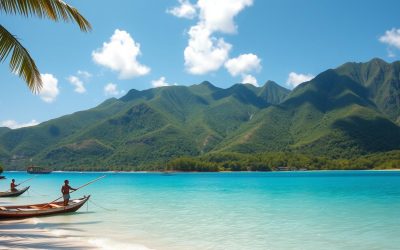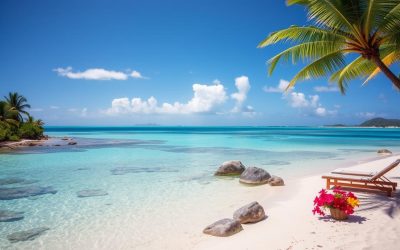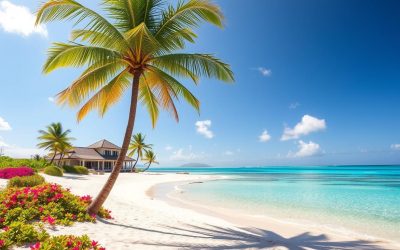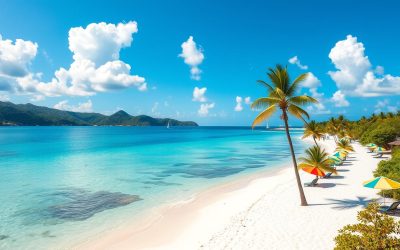Did you know that St. Vincent & The Grenadines is made up of 32 islands and cays? This Caribbean gem offers a unique blend of natural beauty and cultural richness. From luxury hotels to pristine beaches, it’s a paradise waiting to be explored.
The islands are known for their inviting accommodations, ranging from private island resorts to historic sugar plantations. Each hotel offers stunning views and a chance to immerse yourself in the local charm. Whether you’re lounging by the beach or exploring the lush landscapes, you’ll find a perfect balance of relaxation and adventure.
Modern amenities meet rich history here, creating an unforgettable experience. As you plan your trip, understanding the local currencies and payment options will ensure a smooth journey. Get ready to discover why this destination is a favorite among travelers seeking both luxury and authenticity.
Discovering St. Vincent & The Grenadines
Nestled in the heart of the Caribbean, this archipelago offers a blend of history and natural beauty. Its rich past, marked by colonial influences and indigenous heritage, has shaped its unique identity. Today, the islands are a harmonious mix of tradition and modernity, making them a must-visit destination.
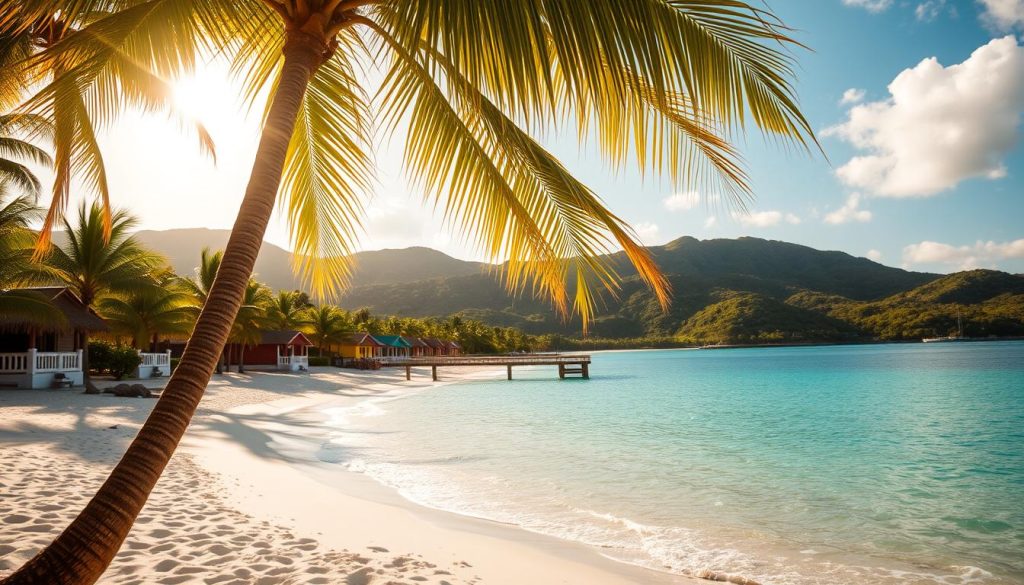
Overview and Historical Insights
The islands’ history is as captivating as their landscapes. From colonial battles to the abolition of slavery, each era has left its mark. Historic landmarks, like old sugar plantations, tell stories of resilience and transformation. Modern-day reconciliation has turned these sites into cultural treasures.
Trade winds keep the climate pleasant year-round, with temperatures averaging 80°F. The dry season, from January to April, is ideal for exploring. Hurricane season runs from June to October, so plan accordingly.
Language, Culture, and Local Customs
English is the official language, but you’ll often hear French patois in conversations. This linguistic blend reflects the islands’ diverse heritage. Local customs, like vibrant festivals and traditional music, add to the cultural richness.
Architecture here is a mix of colonial and Caribbean styles. From colorful homes to historic churches, every structure tells a story. Immersing yourself in these traditions will deepen your connection to the islands.
The beach scene is unparalleled. Whether you’re lounging on pristine sands or snorkeling in crystal-clear waters, you’ll find endless ways to unwind. The restaurant scene is equally impressive, offering everything from upscale dining to local street food.
| Best Time to Visit | Highlights |
|---|---|
| December – April | Dry season, perfect for outdoor activities |
| June – October | Hurricane season, fewer crowds |
Plan your trip during the dry season for the best experience. Each day brings new adventures, from hiking lush trails to exploring vibrant markets. As a visitor, you’ll leave with unforgettable memories and a deeper appreciation for this Caribbean gem.
Navigating the Currency: Eastern Caribbean Dollar Essentials
Understanding the local currency is key to a smooth travel experience. The official eastern caribbean dollar (XCD) is widely used, but US dollars are also accepted in many places. Knowing how to manage both will save you time and money.
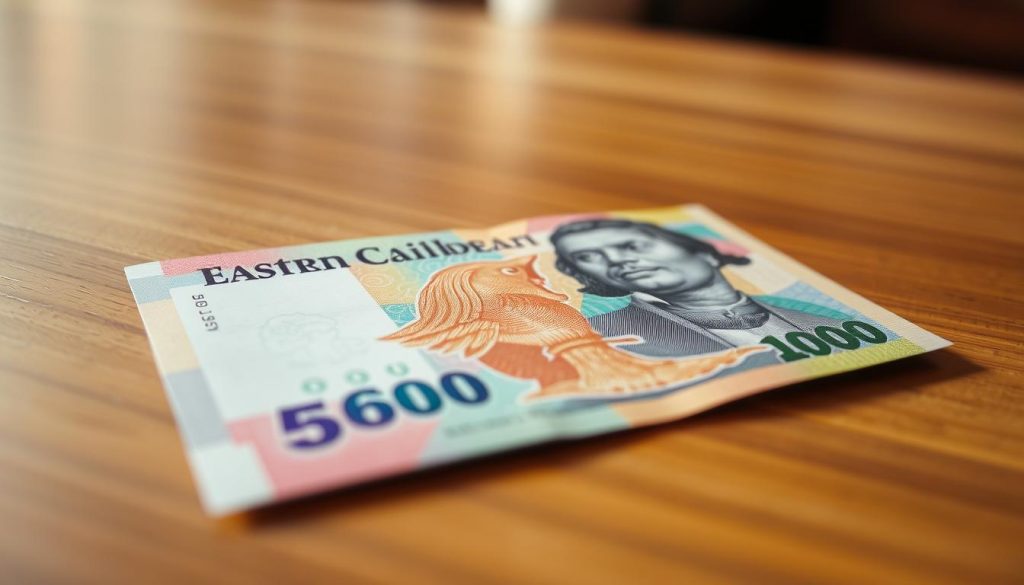
Understanding Currency Exchange Basics
Exchanging your money to the local caribbean dollar is straightforward. Banks and authorized exchange bureaus offer competitive rates. Always confirm the price in both currencies to avoid confusion. This ensures you get the best deal.
It’s helpful to carry small denominations of both XCD and US dollars. Many vendors prefer local currency for smaller transactions. Larger establishments, like hotels, often accept US dollars but may give change in XCD.
Using US Dollars and Local Payment Insights
US dollars are widely accepted, especially in tourist areas. However, you’ll often receive change in the local caribbean dollar. To avoid surprises, always ask which currency is being used for pricing.
When dining out or shopping, double-check the price in both currencies. Some places may display prices in US dollars, while others use XCD. This simple step helps you stay within budget.
By understanding these basics, you’ll navigate payments with ease. Whether using the eastern caribbean dollar or US dollars, you’ll enjoy a hassle-free experience.
St. Vincent & The Grenadines: Ultimate Travelers Guide to Currencies & Payments
Exploring the islands is a breeze when you know the local payment methods. From credit cards to cash, understanding your options ensures a smooth and enjoyable trip. Here’s a guide to help you navigate payments like a pro.
Understanding Local Payment Methods
Most hotels and restaurants accept credit cards, making them a convenient option for travelers. However, smaller vendors and local markets often prefer cash. Carrying both ensures you’re prepared for any situation.
For transportation, taxi services are widely available. Always agree on the fare in local currency before starting your journey. This avoids misunderstandings and ensures a fair price.
Credit Card Use and Cash Tips
Using a credit card is ideal for larger purchases or dining at upscale restaurants. However, smaller transactions, like buying souvenirs or street food, are best handled with cash. Keep small denominations handy for convenience.
When it comes to tipping, it’s customary but not mandatory. A 10% tip at restaurants is appreciated, while rounding up the fare for taxi drivers is a kind gesture.
Union Island is a best place visit for its stunning beaches and relaxed vibe. Whether you’re exploring its shores or enjoying local cuisine, knowing how to pay ensures a hassle-free experience.
| Payment Method | Best Use |
|---|---|
| Credit Card | Hotels, restaurants, and larger purchases |
| Cash | Local markets, taxis, and small vendors |
By mastering these payment methods, you’ll enjoy your trip without any financial surprises. Whether you’re relaxing on Union Island or exploring hidden gems, you’ll be ready for every adventure.
Managing Your Payments and Budget on the Islands
Planning your budget for a Caribbean getaway doesn’t have to be stressful. With a few simple strategies, you can enjoy your vacation without worrying about overspending. Whether you’re staying at a luxury resort or exploring local markets, knowing how to manage your money ensures a smooth experience.

Strategies for Budgeting Your Stay
Start by estimating your daily expenses. Accommodation, meals, and activities are the main categories to consider. For example, a mid-range resort might cost around $100 per night, while dining out could add $20-$30 per meal.
Check the exchange rate before your trip. This helps you understand how much you’re spending in your home currency. Apps or online tools can track your expenses in real-time, making it easier to stick to your budget.
Plan your spend day wisely. Prioritize must-do activities and allocate funds accordingly. This way, you won’t miss out on the highlights of your destination.
Hotel, Restaurant, and Resort Payment Options
Most resorts and hotels accept credit cards, but it’s always good to carry cash for smaller transactions. Local markets and street vendors often prefer cash, so keep small denominations handy.
When dining out, check if the price is listed in local currency or US dollars. Some places may charge a service fee, so it’s customary to leave a 10% tip if it’s not included.
For a seamless experience, inform your bank about your travel plans. This prevents your card from being flagged for suspicious activity. ATMs are widely available, but use those affiliated with major banks to avoid high fees.
By following these tips, you’ll make the most of your vacation without breaking the bank. Whether you’re relaxing at a resort or exploring the islands, smart budgeting ensures a stress-free trip.
Local Banking, ATMs, and Cash Management
Managing your finances while traveling can be straightforward with the right tips. In Kingstown, accessing cash and banking services is easier than you might think. However, it’s essential to plan ahead to avoid inconvenience.
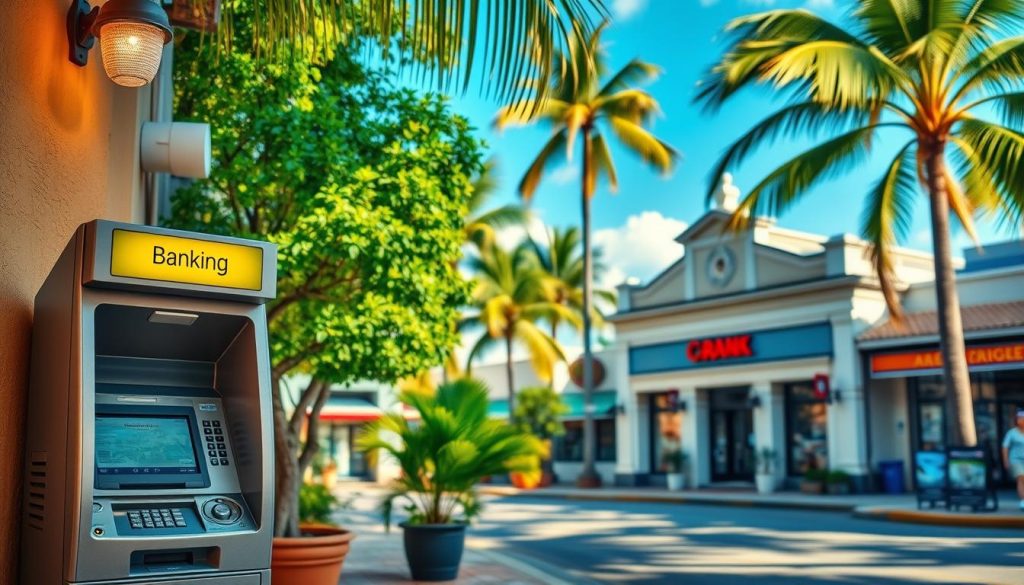
Finding ATMs and Bank Locations in Kingstown
ATMs are available in Kingstown, but they are limited. Most are located near banks or in shopping areas. Always carry your passport when accessing these services, as it’s often required for identification.
Banks in Kingstown operate during standard business hours, typically from 8 AM to 3 PM. Plan your visits accordingly to save time. If you’re traveling to other islands, consider using ferry services to transport cash securely.
Best Practices for Handling Cash Safely
Carrying large amounts of cash is not recommended. Instead, withdraw smaller sums as needed. Keep your valid passport and other valuables in a secure place, such as a hotel safe or a hidden travel pouch.
When using ATMs, choose those located inside banks or well-lit, busy areas. Avoid using them after dark to minimize risks. As one traveler shared, “Being cautious with cash management ensures a stress-free trip.”
| Banking Tip | Why It’s Important |
|---|---|
| Carry your passport | Required for ATM and bank transactions |
| Use ATMs during the day | Safer and more reliable |
| Plan around ferry schedules | Efficient cash transport between islands |
Recent trends in the banking year have improved security measures, but it’s still wise to stay vigilant. By following these tips, you’ll handle your finances with confidence and focus on enjoying your trip.
Travel Essentials: Electricity, Internet, and Communication
When traveling to a new destination, understanding the basics of electricity and connectivity can make all the difference. From keeping your devices charged to staying online, these travel tips will ensure you’re prepared for every way your journey unfolds.
Electrical Standards and Adaptor Requirements
The islands use a voltage of 220-240V/50Hz, with British-style three-pin sockets. If you’re coming from the U.S., you’ll need a thing like a universal adaptor to plug in your devices. Most hotels provide adaptors, but it’s wise to carry your own to avoid inconvenience.
For your flight, pack a power bank to keep your phone and other gadgets charged. This is especially useful during long layovers or delays. Double-check your devices’ voltage compatibility to avoid damage.
Staying Connected: Mobile and Internet Access
Staying connected is easier than you might think. Most hotels and cafes offer free Wi-Fi, but for reliable access, consider purchasing a local SIM card. This is a great way to stay online without incurring roaming charges.
Carry a reusable water bottle to stay hydrated while exploring. Many places have filtered water stations, making it easy to refill. This small travel tip can save you money and reduce plastic waste.
By planning ahead, you’ll ensure a smooth and connected trip. Whether it’s powering your devices or staying online, these essentials will keep you ready for every adventure.
Exploring Attractions and Experiences in St. Vincent & The Grenadines
The islands of St. Vincent & The Grenadines are a treasure trove of natural wonders and cultural delights. From pristine beaches to vibrant local markets, there’s something for every traveler to enjoy. Whether you’re seeking adventure or relaxation, these islands offer unforgettable experiences.
Top Beaches, Tours, and Island Adventures
One of the must-visit spots is the Tobago Cays, a group of small islands surrounded by crystal-clear waters. This marine park is perfect for snorkeling and diving, offering a chance to explore vibrant coral reefs and marine life. For a unique adventure, consider island-hopping to nearby gems like Mustique or Bequia.
If you’re a fan of hiking, the trails leading to La Soufrière volcano are a must. The leeward trail takes about 7 hours round trip, while the windward trail is shorter but equally rewarding. These hikes offer stunning views and a chance to connect with the island’s natural beauty.
Local Restaurants, Bars, and Market Finds
When it comes to dining, the islands don’t disappoint. Visit a beach bar for a refreshing drink and a laid-back vibe. Many of these spots also serve local dishes, giving you a taste of the islands’ culinary heritage. Don’t miss trying breadfruit, a staple in the local diet, often served fried or roasted.
For a more immersive experience, explore the local markets. Here, you’ll find fresh produce, handmade crafts, and unique souvenirs. These markets are a great way to support local businesses and take home a piece of the islands’ culture.
If you’re planning to extend your trip, consider visiting nearby St. Lucia. This neighboring island offers additional attractions and experiences, making it a great addition to your itinerary.
From the breathtaking Tobago Cays to the lively beach bars, every moment spent here is a memory in the making. Whether you’re exploring hidden island cay adventures or savoring local flavors like breadfruit, you’ll leave with a deeper appreciation for this Caribbean paradise.
Insider Tips for a Hassle-Free Caribbean Vacation
Planning a Caribbean getaway? Here’s how to make it seamless and stress-free. From visa requirements to the best time to visit, these insider tips will help you maximize your experience while saving money.
Visa, Consular, and Emergency Information
Before you travel, ensure your passport is valid for at least six months. U.S. citizens don’t need a visa for stays under 90 days, but always check the latest requirements. Keep a copy of your passport and emergency contacts handy.
For consular assistance, the U.S. Embassy in Barbados covers St. Vincent and the Grenadines. Save their contact information in case of emergencies. Travel insurance is also recommended to cover unexpected medical or travel issues.
When to Visit for the Best Rates and Experiences
The peak season runs from December to April, offering ideal weather but higher prices. For fewer crowds and better rates, consider visiting during the shoulder season from May to June or September to November.
Hurricane season spans June to November, with the highest risk in August and September. If you’re flexible, this can be a great time to find deals at all-inclusive resorts.
Around St. Vincent, the dry season is perfect for outdoor activities like hiking and snorkeling. Plan your trip during this best time to enjoy the islands’ natural beauty without interruptions.
| Travel Period | Highlights |
|---|---|
| December – April | Peak season, ideal weather, higher prices |
| May – June, September – November | Shoulder season, fewer crowds, better rates |
| June – November | Hurricane season, potential for deals |
Choosing the best place to stay can enhance your trip. Look for all-inclusive resorts that offer value for money, especially during the shoulder season. With these tips, you’ll enjoy a hassle-free Caribbean vacation.
Conclusion
Your island adventure awaits with a blend of culture and convenience. From savoring fresh fish to indulging in tropical fruit, every bite adds to the experience. Don’t miss the chance to explore historic gems like Fort Charlotte, which offers a glimpse into the region’s rich past.
The eastern Caribbean vibe is evident in every corner, from bustling markets to serene cay escapes. Understanding local payment methods ensures a smooth journey, letting you focus on the beauty around you.
With these tips, you’re ready to embrace the islands’ charm. Whether you’re dining, shopping, or exploring, every moment becomes a cherished memory. Enjoy your adventure!
The above is subject to change.
Check back often to TRAVEL.COM for the latest travel tips and deals.
Here are some Tours & Sightseeing suggestions that might pique your interests!

